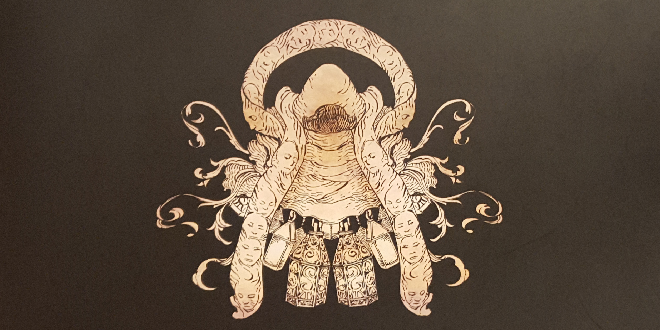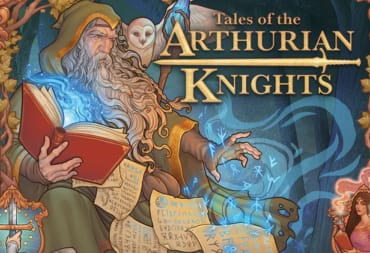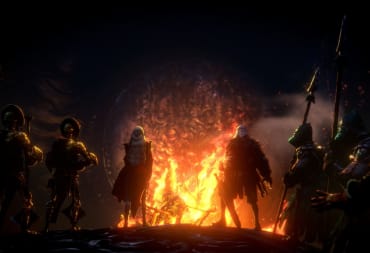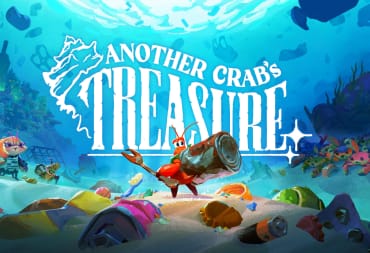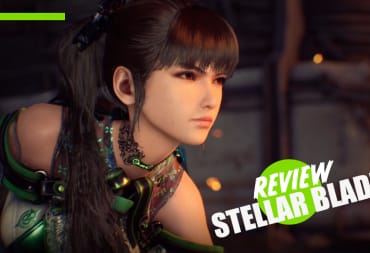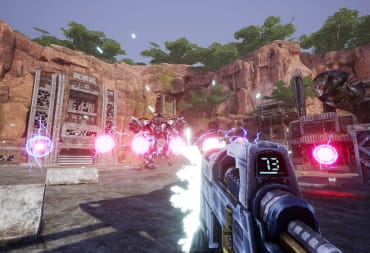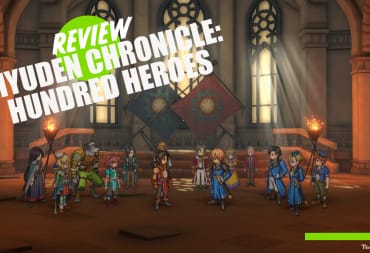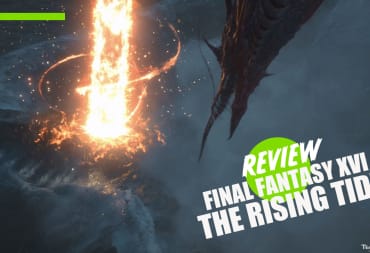I've already written nearly twenty thousand words about Kingdom Death: Monster, including crowning it as TechRaptor's Boardgame of the Year 2015, yet I have been waffling back and forth for a while about writing an actual review of the game. I figured a thematic telling of a campaign would get the point across, to anyone willing to spend the time to read it, of why this is my favorite board game that I've ever played. A numbered score matters though, as much as I wish it didn't, and so I feel I'd be remiss if I didn't give Kingdom Death: Monster a proper review, so let me tell you why this game is an instant Classic.
Let's start with the miniatures. Kingdom Death: Monster hit Kickstarter in 2012 with pictures of some of the most incredible miniatures that had ever been seen, next to a brief description of some of the concepts of gameplay. The initial campaign asked for $35,000. By the end of the campaign, over $2,000,000 had been raised and expectations were through the roof. An incredible amount of miniatures had been added to the game, and a large number of expansions, each with its own set of stunning miniatures had been unlocked and made available to backers. The quality of the miniatures was never in doubt, as Kingdom Death continues to produce and sell one-off resin miniatures of exceptional quality. When the game finally arrived, the plastic miniatures that came with the core game lived up to the hype, and were exactly as promised.
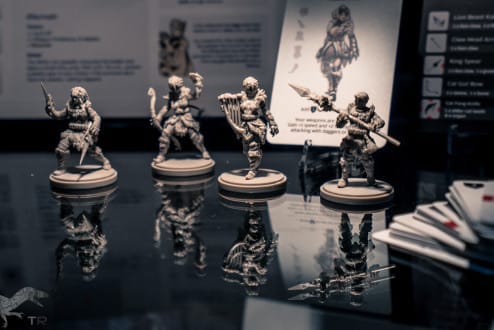
So much work went in to the quality of the miniatures that the game itself could easily have been tacked on as an afterthought. As the months turned into years, and only the most meager of gameplay details emerged, many people suspected that this is exactly what was happening with the game. I fell into this category as well, and I began to write off the game as an afterthought. We ran into the Kingdom Death crew during GenCon 2015 and spent some time talking with designer Adam Poots about the game as well as playing a quick demo. What we saw renewed my interest in the game, yet didn't prepare me for how amazing the final product would be once I got my hands on it and finally dug into it.
Death awaits around every corner in Kingdom Death: Monster. From the very opening moments of each campaign, when the initial four survivors awaken only to be immediately thrust into a life and death battle, through various trials and tribulations of the game's myriad events, to childbirth complications, mental health issues and even old age, the survivors are in a constant struggle for survival in a world that wants nothing more than to grind them to dust. The world of Kingdom Death: Monster is one of perpetual darkness, only broken by feeble lantern light, and players quickly learn to fear, or at the very least be extremely cautious of, each and every other inhabitant of the world. The story told across the campaign isn't one of heroics—although heroes can emerge to rise to lofty heights, those same heroes can fall just as quickly—it is a story of survival.
Whereas most campaign-based board games shine the spotlight on specific characters, the focus of Kingdom Death: Monster is on the player settlement. Each settlement grows and changes over time. Not only does the settlement's population grow over time via births, and shrink via survivor deaths, but the settlement itself changes based on player choices. New buildings can be constructed, allowing for new items and gear to be crafted, increasing survivor potency in combat. Innovations can be discovered that grant new abilities to survivors, such as the ability to run away from combat, or move further when fighting a monster.
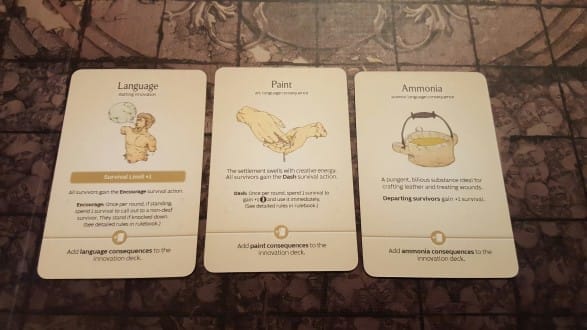
Most importantly, when certain milestones are reached, such as the first time a survivor dies or the first time a child is born, the players must collectively decide which Principle to dedicate their settlement to. Will you decide to Protect the Young, or will you live by Survival of the Fittest? Do you bury your dead in Graves, or will you Cannibalize the corpses for extra resources? Each choice has a profound effect on the outcome of a campaign, especially because each choice isn't created equally. As these choices are made, the settlement forms a personality of its own, and while the settlement's survival needs to be the main focus, there is still a huge amount of attention given to each individual survivor.
While no survivor is more important than the settlement as a whole, they can still take center stage in the story that unfolds during a campaign. The survivors gain experience as they hunt monsters, which allows them to grow stronger, learn deadly fighting arts, equip stronger gear and weapons, and even become proficient with or master certain weapons. These same survivors are also susceptible to permanent injury, dismemberment, mental disorders, and even death. Death is not only possible, but likely. The world of Kingdom Death is out to kill survivors and will do so without mercy. The inherent, ever present danger provides an almost inevitable sense of attachment to those survivors that do survive. It is easy to become emotionally invested in survivors, especially those who seem to defy the odds and escape the inescapable. Each survivor has their own story inside the larger story of the settlement, and while most of those stories are cut short before they leave a lasting mark, there are those who stick around long enough to forge their own epic tale, and leave their mark on both the campaign and the players who not only witnessed that story but were directly responsible for it.
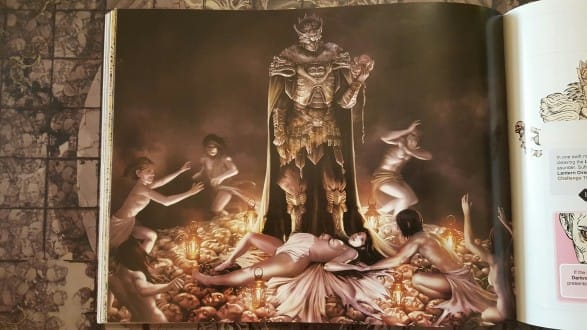
The game itself is light on story elements, providing snippets and glimpses at the world as a whole, and leaves the majority of the tale to be written by the players and the choices that they make. The emergent narrative is strong enough to leave lasting memories as well as being personal enough to have real emotional impact. Losing survivors is inevitable, but losing your favorite survivor that you have spent hours with, whose presence feels vital to the story can be heartbreaking. Knowing that heartbreak awaits around every corner adds an edge to the thrill that I have never experienced in a board game, being more akin to losing a D&D character after hours and hours of play.
The potential for incredible storytelling wouldn't exist if Kingdom Death: Monster didn't didn't rest on such a solid mechanical foundation. Dice rolls are everywhere, but rarely do they come without at least some player agency. There are tables galore in Kingdom Death: Monster, from determining the outcome of reaching certain age milestones to deciding the effects of drinking from a fountain that the survivors stumbled across while on the trial of their next quarry. On first blush, and often during a first, inevitably failed campaign, it can appear as if you are merely rolling dice in the dark, hoping the dice gods smile on you. What could be an exercise in frustration is well tempered by the fact that the game excels at using failure as a teaching tool. The entire game is designed around learning from your mistakes, and it places the tools in your hands to try to avoid those mistakes. The sense of progression is ever-present, even in utter defeat and a failed campaign, as the knowledge gained in that failure can be put to use in future campaigns.
Kingdom Death: Monster uses this same learn-via-failure idea in the fights against the game's monsters. The combat is grid and dice based, which could easily spell disaster for a game that asks you to spend dozens of hours per campaign, but it tweaks the formula in such a way that it allows you mitigate the luck of the dice not just via bigger numbers and better stats, but by teaching you how each monster behaves and expecting you to learn from, prepare for, and react to those behaviors accordingly. Whether you hit and or wound the monster is almost always going to come down to the roll of the dice, but whether you will succeed in actually killing the beast is always down to the choices you make, whether it be the gear that you outfitted your survivor in to where you have chosen to position yourself in relation to the monster at the end of each of your turns.
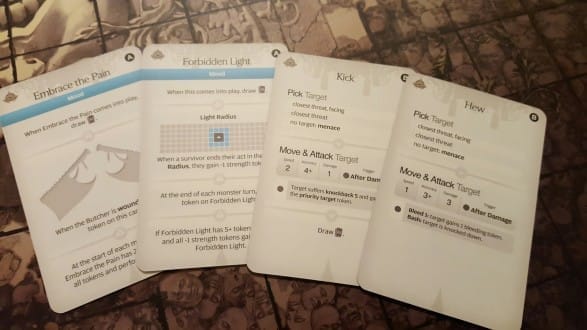
Each monster is controlled via an AI deck that simultaneously functions as its health, that changes and grows directly with the level of the monster being fought. While the monster is fresh and healthy, it has a wide range of behaviors, but when it begins to take wounds its actions begin to become more predictable. When wounded, the cards removed from the AI deck are removed face down, so it can be difficult for players to determine exactly which actions the monster will no longer perform versus which it will start to perform more regularly. Often, the monster will become predictable and easy to kill, but sometimes, if players are not careful, or just unlucky, the monster will be left with its deadliest combination of behaviors, and what looks to be a near victory can turn into devastating defeat. The ability to weaponize knowledge offers a great sense of accomplishment and progression, while leaving enough room for luck that there is always at least a small sense of risk.
Before players can actually fight their quarry, they must hunt them. The hunt phase presents its own unique set of challenges to the players. Each quarry has their own deck of Hunt Events that need to be faced, and all are bolstered by 100 random Hunt Events included in the rulebook. Like the behaviors during battle, each quarry monster's hunt has hazards that need to be experienced, learned, and prepared for, while the random Events serve to ensure that even the most well-prepared hunting parties have to stay on their toes. The hunt itself should never be taken lightly, especially as higher levels of quarry are hunted, as death awaits the unwary and unlucky as readily on the path to the fight as it does in the fight itself, and that path just grows in length as the monster level increases. Other than a few extremely dangerous Nemesis encounters, players will be fully in control of the monsters that they hunt and, while it can be tempting to hunt only the quarry that players are most familiar with, it places them at risk of not being able to craft gear and weapons that might be needed down the road as the campaign progresses.
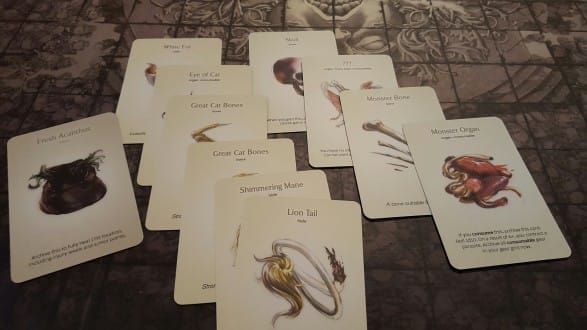
The Nemesis are a different story all together. They show up at fixed intervals throughout the campaign and force the players to fight them. Each of these fights is unique, challenging, and often devastating. Careful planning, preparation, and tactical considerations need to be made during these fights, and each has the potential to go poorly for even the most prepared survivors. They almost exist as a reminder to the players that, no matter how well they are doing, their survivors are the bottom of the food chain, and they should never forget that. They are challenging, terrifying and, when players manage to emerge victorious, exhilarating.
The campaign itself is broken down into Lantern Years, with each year composed of a Settlement Phase, a Hunt Phase, and a Showdown with the chosen quarry, with many Lantern Years also presenting the players with special events that they need to deal with. The Hunt and Showdown phases are self explanatory, but the Settlement Phase is where most of the truly memorable events and decisions take place, and where the players have to make the decisions that will effect the settlement as a whole and decide how and where to spend the resources gained from successfully hunting and slaying a monster. The choices are rarely straightforward, and the number of resources on hand, even after successful hunts, is almost never enough to do everything that the players will want to do at any one time.
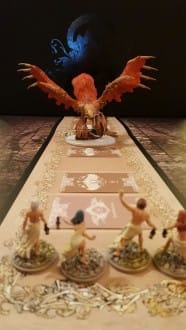
Kingdom Death: Monster rests firmly on three cornerstones. The components are sensational; the storytelling is amazing, rivaled only by tabletop RPGs such as D&D and Pathfinder; and the mechanics are rock solid. The sheer breadth, depth, and weight of the game should show cracks forming in the veneer, and there are some ambiguities in the rules and various card interactions, but, considering the sheer scope of the game, it is incredible that it all works together so seamlessly. It's abundantly clear that the large gap of time from the end of the Kickstarter until the final arrival of the game was spent polishing Kingdom Death: Monster to an incredible shine.
A note on solo play: Kingdom Death: Monster provides an excellent solo experience, although there are some situations in the game that are obviously designed to be experienced by multiple players. Even then, there are little tweaks written directly into those events that give a nod to the solo player. It is definitely better with multiple players, but only just.
A note on play time: A Kingdom Death: Monster campaign is most easily broken down into Lantern Year chunks, with each Lantern Year averaging 1 - 2 hours in length at the beginning of a campaign and stretching into the 2+ hour mark towards the end of a successful campaign, including set-up and tear-down. A successful campaign will easily provide 30+ hours of play time if the players are trying to finish the campaign at its earliest possible resolution point, and can stretch much longer.
A note on “chrome”: The components in Kingdom Death: Monster are second to none. The art is amazing, the cardboard is top quality and the plastic miniatures are stunning. The miniatures are all model kits, so prepare to spend some time constructing them. While the construction can appear to be a daunting task, there are some excellent resources, such as VibrantLantern.com, that proved step by step, easy to follow instructions.
The bottom line:
Kingdom Death: Monster is amazing, it's deep, it's fascinating, it's thought provoking, it's complex, it's genre redefining, and it's expensive, yet it's worth every penny. It's a game that should only appeal to the most niche of audiences yet takes hold of every person that I've shown it too. It came to fruition on the strength of its incredible miniatures and shot into the stratosphere on the strength of its gameplay. The amount of content in the base game is staggering, and with the sheer volume of expansion content on the very near horizon it has the potential to become a hobby unto itself.
Get this game if:
You want the deepest, most emotionally engaging board game available.
You want a game with persistent characters who grow in personality as much as power and face the possibility of permanent death.
You like campaign driven games.
You want to make meaningful, difficult decisions.
Avoid this game if:
You hate any game that contains dice.
You avoid games with adult themes such as nudity, violence, and death.
The copy of Kingdom Death: Monster used for this review was purchased by the reviewer.
Review Summary
Kingdom Death is an instant classic. No game before has done what it does, and it's hard to imagine any game willing to take the risk to try to outdo it. The core game offers an insane amount of content that is only going to grow exponentially as the expansions are released.
(Review Policy)Have a tip, or want to point out something we missed? Leave a Comment or e-mail us at tips@techraptor.net
